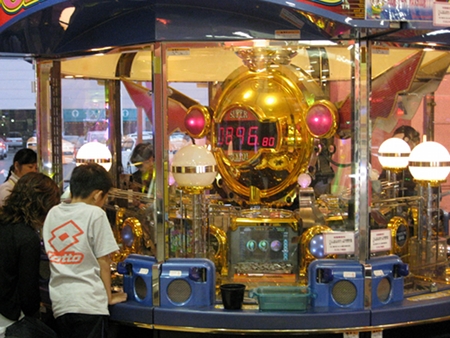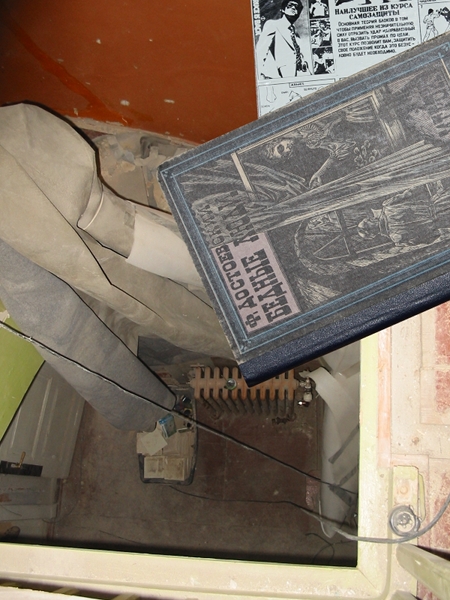
The above counter is not a Geiger counter but a money counter in a game area in a shopping center in Japan.
This blog post is a comment on how fast the replacement of fossil and nuclear power with renewable power generation may happen.
In the article draft at the randform post “New economic schemes in games” it was illustrated by a quick calculation that alone solar power can in principle replace fossil and nuclear power. However apart from the technological feasibility a major obstacle is of course the economical feasibility.
There is a new study (277 pages 5.5. MByte) by the german ministry of economy with the title: “Vorraussetzungen einer optimalen Integration erneuerbarer Energien in das Stromversorgungssystem”
(I couldn’t find the link path of the study from the front webpage of the ministry…its seems to be a little hidden…)
This study displays how economical considerations play a role in Germanys development of renewable energies; from page 134 of the study:
“Die darauf aufbauende Analyse der Auswirkungen auf das Stromerzeugungssystem zeigt, dass die Auswirkungen eines EE-Anteils von bis zu 40% für den konventionellen Kraftwerkspark technisch realisierbar und wirtschaftlich vertretbar sind. Ab einem EE-Anteil von 40% sind ohne Veränderungen der rechtlichen und regulatorische Rahmenbedingungen sowie technischer Regelwerke zum einen erhebliche ökonomische Verwerfungen auf den Märkten zu erwarten. Zum anderen ist ein solcher EE-Ausbaupfad mit einer erheblichen Kosten- und Preissteigerung verbunden. So steigen bspw. die Kosten für Systemdienstleistungen und damit auch die Netznutzungsentgelte im Vergleich zur 30%-Variante deutlich. Zusammen mit der enormen Erhöhung der EEG-Umlage liegen die Strompreise für Haushalte im Jahr 2020 in der 50%- Variante rund 20% höher im Vergleich zur 30%-Variante. Die Mehrkosten die von den Verbrauchern im Jahr 2020 in der 50 %-Varianten gegenüber der 30 %-Variante zu tragen sind, belaufen sich auf rund 20 Mrd. €2009. Grundsätzlich ist aber in keiner der untersuchten EE- Ausbauvarianten die Versorgungssicherheit in Form von ausreichender installierter Kraftwerksleistung oder die Versorgungszuverlässigkeit in Form ausreichender Erbringung von Systemdienstleistungen bis 2020 gefährdet. “
Rough translation without guarantee:
The depending analysis of the effects on the electric-current-generation-systems displays that the implications of a 40% share of renewable energies [comment: for electricity generation until the year 2020] are fully realizable and economically justifyable for conventional powerplant configurations. Without a change in the juridicial and regulatory framings, as well as without a change in technical regulatory regimes there would be however above a 40% share considerable economical warpages. So for example the costs for system services as well as the costs for the usage of electric grids are clearly higher than for the 30% variant. The additional costs for consumers for the year 2020 for the 50% variant versus the 30% variant are about 20 billion Euros (2009). In principle however for all considered variants there is no danger for the security of energy supplies in form of installed power plant power or service reliability until 2020.
So according to this study making Germany get half of their electric energy from non-fossil and non-nuclear power by 2020 would have an additional cost of about:
20 billion Euros
As a comparision:
the bank HRE got sofar about 100 billion Euros in help and guarantees.
(According to Wikipedia of this sum 87 billion Euros are state money (?), Bloomberg sais in the article “Hypo Real Estate Receives Extension of Financial Aid (Update1)” that “the rescue package includes alone 52 billion euros in Soffin guarantees.”)
It currently looks as if this Hypo Real Estate bank has really no future (see e.g. the german article “Experten empfehlen Abwicklung der HRE”).
This was somewhat forseeable already two years ago and I wonder now and I wondered back then what this does imply for the german state obligations. May be this information is again hidden somewhere on the webpage of german ministry for economy and I just can’t find it.
->see also randform post About the “Concept for an integrated energy-research program for Germany”

